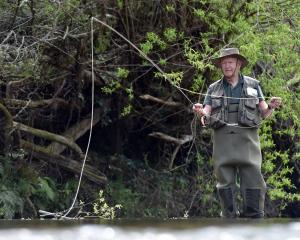
Although several streams rose at the beginning of the week most have dropped again.
For instance, the Waipahi came up a little and is now at a good fishable level so too the Pomahaka which rose a lot but has dropped rapidly.
The extra water in the Pomahaka could have brought in a run of sea trout.
The main area for targeting the Pomahaka sea trout is the top of the river but they can be caught in the middle reaches too at this time of year.
I crossed the Waitaki the other day and it looked perfect — that brilliant clear blue colour showing it is well worth fishing either with a nymph during the day or a sedge on a calm evening.
The extra water in the Taieri could have brought in the sea trout especially in the lower reaches.
There is a little colour in the river which is good for spin fishers. Spin fishing for sea trout can be very effective as a lot of water can be covered quickly.
Sea trout often take up lies that resident fish do not occupy.
Resident fish are feeding whereas sea trout rarely feed once back in freshwater their main reason for the choice of a lie is the lack of effort needed to maintain their position.
When the water is clear sea trout take nymphs well, I have caught quite a few on the good old hare’s ear nymph as well as on a gold bead nymph. But of course, they are the flies I fish the most so naturally I catch the most fish on them.
Water temperature has dropped several degrees over the last couple of weeks due to cooler weather and longer nights.
Generally, trout will not be as active until the water warms up later in the day.
This applies mainly to brown trout as they are starting to develop spawn which has an energy demand so trout will feed when there is plenty of food to find.
If there is little food they would expend more energy that they gain from finding it.
Browns are more likely to be seen rising in the early afternoons to a hatch of mayflies although if the hatch is sparse they may not bother much to the disappointment of fly fishers.
Last week, I wrote about fishing deep in stillwaters if there are no rising fish and I have been out a couple of times and put it into practice.
At one point I had not had a take in a couple of hours so I went to a spot where I could reach deep water, more than a couple of metres deep. Casting as far as I could I let the flies sink for as long as I could restrain myself from retrieving.
Two takes one before starting to retrieve and the other in the first couple of metres.



